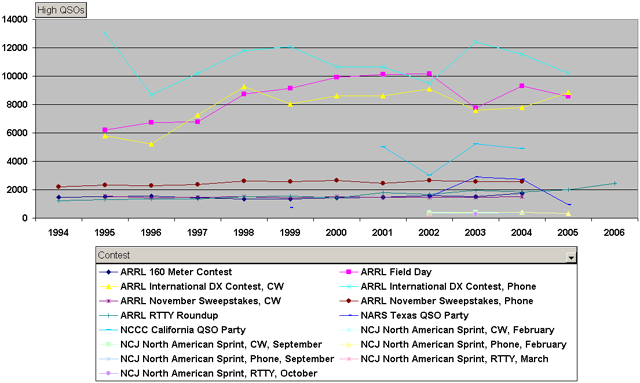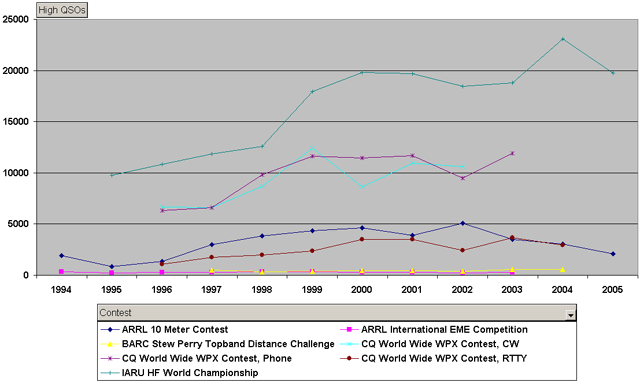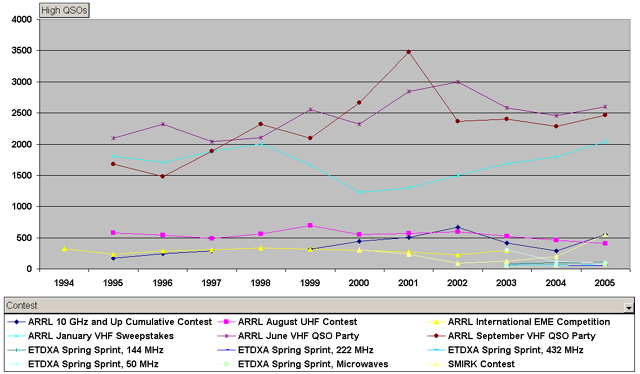High QSO Totals Offer Insight
Kenneth E. Harker (wm5r)
on
October 13, 2006
View comments about this article!
Every so often, the conversation on the contesting email discussion forums takes a familiar turn. Most contesters who have been around the sport for a year or more likely already know the theme. Contesting is doomed. Too many contesters are getting too old and the sport as we know it will cease to exist in the not-too-distant future. All sorts of anecdotal stories come out, tales of would-be contesters giving up because of deed restrictions, lack of mentoring, or the wrong kinds of incentives to participate. It's a dire crisis, and contesting is on the very brink of extinction.
To try to see if contesting really was on the decline as many claim, I analyzed log submission totals for ARRL contests spanning the most recent decade for which log submission totals were then available. The results were presented in this article, and the conclusions were mixed. HF contests that included DX activity (especially on CW) had seen significant growth in log submissions, HF contests that have primarily domestic participation in North America saw small to no growth, and North American VHF contests as whole saw significant declines in the number of logs submitted. Since that article has been published, hundreds of thousands of line scores have been collected in the Contest Score Database. Some examination of the log submission totals for non-ARRL contests shows that the number of logs for most HF contests worldwide have been growing, especially among CW DX contests, RTTY contests, and the Russian DX Contest.
"Log submissions may not tell the whole story!" some have claimed. It's easier in 2006 to email in a log than it was to submit a log to a contest sponsor in 1996, especially in Eastern Europe. Maybe the increase in log submissions does not imply that more stations are active after all, just that stations find it easier to submit logs. Certainly there are those that remain convinced that contesting is dying despite the increase in log submissions.
Another metric by which we might be able to judge the relative health of contesting is to consider the high QSO totals for each contest over the past dozen years where we have the data. If there are fewer stations on the air to work, the high QSO totals should presumably be lower, and vice versa. The time period from 1994 to 2006 spans a complete solar cycle. Will the high QSO totals be as large at the bottom of the cycle in 2005/2006 as they were at the previous bottom in 1994/1995? The graphs below separate the contests for which line score data is available for convenience of scale, since trying to fit all the contests on one chart would make it too difficult to use.
North American HF Contests

Both ARRL Field Day and the ARRL International DX Contest, CW show clear improvement in QSO totals. The solar cycle naturally plays a role, but even so, the 2005 high QSO totals are much higher than the 1995 high QSO totals.
European HF Contests

The DARC Worked All Europe Contest shows significant variation from year to year, but 2004 was the second-largest high QSO total ever and the top station in 2004 made over 1000 more QSOs than the top station in 1994. WAE RTTY shows steady high QSO growth year after year for a decade. The SRR Russian DX Contest has clearly grown not just in log submissions, but in QSOs worked, with the 2005 high QSO total over 50% higher than the 1997 high QSO total and higher than the highest QSO totals worked during the solar cycle peak.
Japanese HF Contests

The JARL All Asian DX Contests experience two years of significantly higher than normal scores and high QSO totals, the apparent result of very spirited competition amongst Asiatic Russians during the solar cycle peak. The high QSO totals in 59 Magazine's JIDX CW contest peaked in 1998/1999, but even at the bottom of the cycle in 2005, they exceeded the 1994 high QSO totals by nearly 100%.
World Wide HF Contests

High QSO totals in the IARU HF World Championship have more than doubled in the past ten years. You can see the influence of the solar cycle in some contests, especially the ARRL 10 Meter Contest, but in none of the contests are the high QSO totals at the end of the solar cycle lower than they were at the beginning.
North American VHF Contests

While the log submission totals for North American VHF contests have been down in recent years, QSO totals have not been similarly affected. Three of the largest VHF contests in North America all have larger high QSO totals in 2005 than in 1995. Only the ARRL August UHF Contest is clearly in a long-term decline of high QSO totals.
Conclusion
Just as log submission totals might not tell the whole story about the health of contesting, a case can be made that high QSO totals might also be deceptive. After all, the state of the art contest stations of 2005 are better designed, use bigger and better antennas, and use better receivers than the top stations in 1995. Expectations of QSO totals are higher in 2005, but perhaps they naturally should be.
The fact remains that when examining the best empirical data available today, published contest line scores, it's difficult to make a case that contesting is in decline, let alone facing certain doom. Log submissions are broadly up across a wide range of contests world wide. The number of QSOs being made by top stations continues to climb, even when the solar flux is falling. There is even significant potential for growth in some newly popular contests, such as the major RTTY contests and the Russian DX Contest, where the growth curves show no signs of slowing down. While it is possible that line score data doesn't reveal everything about the current health of radiosport, what it does reveal seems mostly encouraging.
|
High QSO Totals Offer Insight
|
Reply
|
|
by N4SL on October 16, 2006
|
Mail this to a friend!
|
Contesting seems to be suffering a bit from the '2nd day slow downs' more and more each year. Hot & Heavy on the first day, by the afternoon of the 2nd day there isn't any fresh blood.
Certainly the fact that individual scores are no longer published in QST will be a contributing factor in the future.
|
| |
|
RE: High QSO Totals Offer Insight
|
Reply
|
|
by ad6zj on October 16, 2006
|
Mail this to a friend!
|
And now for an unscientific survey of one...
In 2003 I stumbled into a contest or two.
In 2004 I participated in 2 contests and submitted logs
In 2005 I submitted 14 contest logs and started posting reasonable scores (for a rookie)
In 2006 I drove 800 miles round trip for a CQP County expedition. I'm up to a dozen contests this year and the season is young.
I'm hooked on this contesting thing.
BTW - What is VHF? ;-)
Thanks to diehard contesters such as N6KI and WN6K for getting me started.
73
de AD6ZJ, Loren
|
| |
|
High QSO Totals Offer Insight
|
Reply
|
|
by N1UR on October 17, 2006
|
Mail this to a friend!
|
Thanks for this great article Ken. I agree, by any measure, you can conclude that HF DX Contesting Worldwide is healthy. Growing? Probably, but certainly not in its demise as many have claimed.
I think that domestic HF contesting is a different story, whether HF or VHF. It would be interesting to see the unique calls data with some attempt to scrub for obvious typos to get a sense for the number of people inspired to get on a radio and "make a couple of Qs".
Kind of wish my stock portfolio had as "bad" numbers as the ones on your chart...hi, hi.
Ed N1UR
|
| |
|
High QSO Totals Offer Insight
|
Reply
|
|
by w4kaz on October 18, 2006
|
Mail this to a friend!
|
Here's an idea for a possibly interesting graphic on the US ham population. How about a histogram showing the ARRL Sweepstakes "year licensed" check being handed out by contest participants. (i.e., 50 entrants 'first licensed' in 1965, 55 in 1966, etc.)
If the peaks of the curves, plotted over time, generally move forward along with the passing years, the US ham contesting population could be considered "stable".
If the curve peaks get stuck on some year in the past, or progress forward more slowly than the time scale(one year), you can presume that the population is aging. We would be saddened to know that our friends are soon to fall off the left of the curve.....
If the curve peaks move forward faster than the time scale, we are picking up new blood, and should rejoice at the new friends we are gaining.
I hope its the latter.
I know the 'first licensed' check is fairly casual regarding accuracy, but its probably close enough for most single ops to use as a guesstimate.
73,
Keith, W4KAZ
|
| |
|
RE: High QSO Totals Offer Insight
|
Reply
|
|
by w4kaz on November 3, 2006
|
Mail this to a friend!
|
Addendum:
Woops. Looks like what I outlined above was done back in 2002 by Bill, N6ZFO. See
http://www.nccc.cc/jug/jug02mar.pdf
w4kaz
|
| |
|
RE: High QSO Totals Offer Insight
|
Reply
|
|
by G8UBJ on November 6, 2006
|
Mail this to a friend!
|
I'm not a serious contester but it was interesting to
see the ages during the JARTS RTTY contest (Exchange is RST + Age)
Few peopple I worked were younger than me! I'm 45 and
in RTTY terms look like a youngster. I worked a few 30 year olds but I only worked one station below 30! (An infant DL at the tender age of 28 years old!).
Like most I started RTTY with a homebrew TU and mechanical monster. I was about 18 Years old�
I know there's a lot of contest activity on RTTY at the moment, but are contesters getting older or do all the foundation/novices go for PSK or something else?
|
| |
|
High QSO Totals Offer Insight
|
Reply
|
|
by kr2q on November 11, 2006
|
Mail this to a friend!
|
Interesting topic which, as pointed out, has been beaten to death, but is always interesting, none-the-less.
Here is my critique (or comments)....
The real question is how to measure the vitality of contesting (again, as was pointed out). There are several approaches: Score, QSO's, log submissions, etc.
As an analogy, how would you meausure the vitality of your local HS Track program...by the number of track team members? By the number of meets? By the number of points accumulated (wins, etc)? Or how about by the number of spectators? Certainly, for an event such as NASCAR, the number of spectators is important.
Well, I think that contesting is somewhat unique in that the "spectators" (casual ops) actually contribute to all of the "measures of success." Should those "spectators" be counted as part of the vitality of contesting? Cleary (at least to me), the sun spot cycle will have a dramatic impact on the number of casual ops who "make some qso's" and hence impact the score of others.
Yes, submitting a log is REAL EASY now, so counting log submissions certainly does has its own issues.
My suggestion:
Look at the Multi-multis (say, to top 10). These are the die-hards of contesting. They absolutely work everything possible everywhere. They do not have to factor in "when will the MUF shift so I should change my run band" sort of thinking that single ops do. They work every other "serious" contester on the air AND they vacuum up every casual op there is by (a) being on the band all of the time and (b) being the loudest signal on the band (and hence very enticing for the casual guy - an "easy" qso).
Track the M/M critical-to-success factors and overlay it on the sunspot cycle. Track: total number of qsos; total number of mults; total score.
This information is available (at least for CQWWDX) since the beginning. I feel that this would be the best indicator of contest health and trends (allowing for the 11 year cycle).
Of course, it works best for contests that have a M/M category. :-)
de Doug KR2Q
|
| |
|
High QSO Totals Offer Insight
|
Reply
|
|
by ve6ex on November 23, 2006
|
Mail this to a friend!
|
Interesting read. The lines/coloured would do better if they were initialed (what did you do with the RAC). It's a lot like reading n1mm bandmap when it's full.
I think addressing/fixing the *turnoffs* would be more to the point. We got dumped in the mags for el'cheepo ads. We get qrmed attacked/harassed and are bound to turn to whatever the rest of the whiners want because we are having fun.
We have to build a structure in contesting that will at least make the beginner feel that they can compete in a class as a beginner and advance accordingly to the top gear/scores. These couloured?? lines to me represent the growth of big gun stations and bigtime efforts that show good in coloured pictures on the front of the radio ads/ cn8ww doing 85 million in mm etc.
Cheers, Dan...
|
| |
|
RE: High QSO Totals Offer Insight
|
Reply
|
|
by ae7dx on November 24, 2006
|
Mail this to a friend!
|
I was just going over some of the checks received in the 2006 CW SS and had a couple of thoughts: 1) The SSB SS will probably result in more recent checks, and 2) I was mostly search and pounce working running stations which I would expect to have older checks. Perhaps studying the log from a station that was primarily running would give a better perspective.
My results (missing years were zero count): 02-2, 00-2, 98-1, 97-2, 96-1, 92-1, 91-1, 90-3, 89-1, 88-1, 85-1, 84-2, 82-2, 81-1, 80-1, 79-4, 78-3, 77-9, 76-6, 75-8, 74-5, 73-6, 72-19, 71-8, 70-6, 69-13, 68-10, 67-4, 66-3, 65-13, 64-6, 63-4, 62-14, 61-6, 60-6, 59-10, 58-20, 57-12, 56-9, 55-10, 54-7, 53-7, 52-3, 51-2, 49-1, 48-3, 24-1 (W6YX), 09-1 (W1MX)
FWIW...SSB counts to come...when I have time...
Jack, NA7RF (CK 57)
(ex AE7DX...operating as K1CD on Sunday in the SSB SS)
|
| |
|
High QSO Totals Offer Insight
|
Reply
|
|
by W5VX on March 24, 2007
|
Mail this to a friend!
|
|
Good reading. It is really easy to talk doom and gloom at the bottom of the sunspot cycle. Let's see if it is still doom and gloom when ten is wide open again!
|
| |
|
Email Subscription
You are not subscribed to discussions on this article.
Subscribe!
My Subscriptions
Subscriptions Help
Other Misc Articles
 DXLog Contest Software
DXLog Contest Software
|

